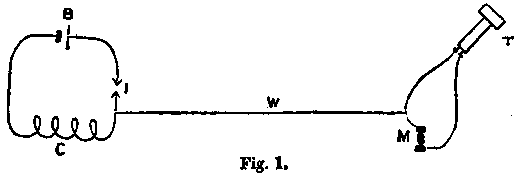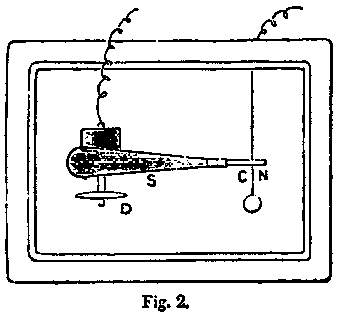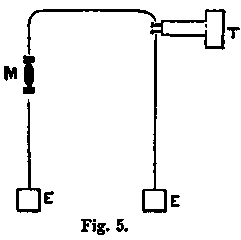DEAR MR FAHIE,--The experiments referred to at page 176 of my 'Fortnightly' article as having taken place "some years ago" were tried by Prof. Hughes when experimenting with the microphone.On receipt of this letter I wrote to Prof. Hughes. In reply he said:--
I have not ceased since then urging on him to publish an account of his experiments. I do not feel justified in saying more about them, but if you were to write to him, telling him what I say, it might induce him to publish.
It is a pity that a man who was so far ahead of all other workers in the field of wireless telegraphy should lose all the credit due to his great ingenuity and prevision.--Believe me, very truly yours,
WILLIAM CROOKES.
"Your letter of 26th instant has brought upon me a flood of old souvenirs in relation to my past experiments on aërial telegraphy. They were completely unknown to the general public, and I feared that the few distinguished men who saw them had forgotten them, or at least had forgotten how the results shown them were produced. . . .On second (and my readers will say, wiser) thoughts, Prof. Hughes sent me the following letter, in the eliciting of which I consider myself especially fortunate and privileged:--
"At this late date I do not wish to set up any claim to priority, as I have never published a word on the subject; and it would be unfair to later workers in the same field to spring an unforeseen claimant to the experiments which they have certainly made without any knowledge of my work."
40 LAGHAM STREET, W., April 29, 1899.
DEAR SIR,--In reply to yours of the 26th inst., in which you say that Sir William Crookes has told you that he saw some experiments of mine on aërial telegraphy in about December 1879, of which he thinks I ought to have published an account, and of which you ask for some information, I beg to reply with a few leading experiments that I made on this subject from 1879 up to 1886:--
In 1879, being engaged upon experiments with my microphone, together with my induction balance, I remarked that at some times I could not get a perfect balance in the induction balance, through apparent want of insulation in the coils; but investigation showed me that the real cause was some loose contact or microphonic joint excited in some portion of the circuit. I then applied the microphone, and found that it gave a current or sound in the telephone receiver, no matter if the microphone was placed direct in the circuit or placed independently at several feet distance from the coils, through which an intermittent current was passing. After numerous experiments, I found that the effect was entirely caused by the extra current, produced in the primary coil of the induction balance.
Further researches proved that an interrupted current in any coil gave out at each interruption such intense extra currents that the whole atmosphere in the room (or in several rooms distant) would have a momentary invisible charge, which became evident if a microphonic joint was used as a receiver with a telephone. This led me to experiment upon the best form of a receiver for these invisible electric waves, which evidently permeated great distances, and through all apparent obstacles, such as walls, &c. I found that all microphonic contacts or joints were extremely sensitive. Those formed of a hard carbon such as coke, or a combination of a piece of coke resting upon a bright steel contact, were very sensitive and self-restoring; whilst a loose contact between metals was equally sensitive, but would cohere, or remain in full contact, after the passage of an electric wave.
The sensitiveness of these microphonic contacts in metals has since been rediscovered by Mons. Ed Branly of Paris, and by Prof. Oliver Lodge, in England, by whom the name of "coherer" has been given to this organ of reception; but, as we wish this organ to make a momentary contact and not cohere permanently, the name seems to me ill-suited for the instrument. The most sensitive and perfect receiver that I have yet made does not cohere permanently, but recovers its original state instantly, and therefore requires no tapping or mechanical aid to the separation of the contacts after momentarily being brought into close union.
I soon found that, whilst an invisible spark would produce a thermo-electric current in the microphonic contacts (sufficient to be heard in the telephone in its circuit), it was far better and more powerful to use a feeble voltaic cell in the receiving circuit, the microphonic joint then acting as a relay by diminishing the resistance at the contact, under the influence of the electric wave received through the atmosphere.
I will not describe the numerous forms of the transmitter and receiver that I made in 1879, all of which I wrote down in several volumes of manuscripts in 1879 (but these have never been published), and most of which can be seen here at my residence at any time; but I will confine myself now to a few salient points. I found that very sudden electric impulses, whether given out to the atmosphere through the extra current from a coil or from a frictional electric machine, equally affected the microphonic joint, the effect depending more on the sudden high potential effect than on any prolonged action. Thus, a spark obtained by rubbing a piece of sealing-wax was equally effective as a discharge from a Leyden jar of the same potential.1 The rubbed sealing-wax and charged Leyden jar had no effect until they were discharged by a spark, and it was evident that this spark, however feeble, acted upon the whole surrounding atmosphere in the form of waves or invisible rays, the laws of which I could not at the time determine. Hertz, however, by a series of original and masterly experiments, proved in 1887-89 that they were real waves similar to light, but of a lower frequency, though of the same velocity. In 1879, whilst making these experiments on aërial transmission, I had two different problems to solve: 1st, What was the true nature of these electrical aërial waves, which seemed, whilst not visible, to spurn all idea of insulation, and to penetrate all space to a distance undetermined. 2nd, To discover the best receiver that could act upon a telephone or telegraph instrument, so as to be able to utilise (when required) these waves for the transmission of messages. The second problem came easy to me when I found that the microphone, which I had previously discovered in 1877-78, had alone the power of rendering these invisible waves evident, either in a telephone or a galvanometer, and up to the present time I do not know of anything approaching the sensitiveness of a microphonic joint as a receiver. Branly's tube, now used by Marconi, was described in my first paper to the Royal Society (May 8, 1878) as the microphone tube, filled with loose filings of zinc and silver; and Prof. Lodge's coherer is an ordinary steel microphone, used for a different purpose from that in which I first described it.2
During the long-continued experiments on this subject, between 1879 and 1886, many curious phenomena came out which would be too long to describe. I found that the effect of the extra current in a coil was not increased by having an iron core as an electro-magnet--the extra current was less rapid, and therefore less effective. A similar effect of a delay was produced by Leyden-jar discharges. The material of the contact-breaker of the primary current had also a great effect. Thus, if the current was broken between two or one piece of carbon, no effect could be perceived of aërial waves, even at short distances of a few feet. The extra current from a small coil without iron was as powerful as an intense spark from a secondary coil, and at that time my experiments seemed to be confined to the use of a single coil of my induction balance, charged by six Daniell cells. With higher battery power the extra current invariably destroyed the insulation of the coils.
In December 1879 I invited several persons to see the results then obtained. Amongst others who called on me and saw my results were--
Dec. 1879.--Mr W. H. Preece, F.R.S.; Sir William Crookes, F.R.S.; Sir W. Roberts-Austen, F.R.S.; Prof. W. Grylls Adams, F.R.S.; Mr W. Grove.
Feb. 20, 1880.--Mr Spottiswoode, Pres. R.S.; Prof. Huxley, F.R.S.; Sir George Gabriel Stokes, F.R.S.
Nov. 7, 1888.--Prof. Dewar, F.R.S.; Mr Lennox, Royal Institution.
They all saw experiments upon aërial transmission, as already described, by means of the extra current produced from a small coil and received upon a semi-metallic microphone, the results being heard upon a telephone in connection with the receiving microphone. The transmitter and receiver were in different rooms, about 60 feet apart. After trying successfully all distances allowed in my residence in Portland Street, my usual method was to put the transmitter in operation and walk up and down Great Portland Street with the receiver in my hand, with the telephone to the ear.
The sounds seemed to slightly increase for a distance of 60 yards, then gradually diminish, until at 500 yards I could no longer with certainty hear the transmitted signals. What struck me as remarkable was that, opposite certain houses, I could hear better, whilst at others the signals could hardly be perceived. Hertz's discovery of nodal points in reflected waves (in 1887-89) has explained to me what was then considered a mystery.
At Mr A. Stroh's telegraph instrument manufactory Mr Stroh and myself could hear perfectly the currents transmitted from the third storey to the basement, but I could not detect clear signals at my residence about a mile distant. The innumerable gas and water pipes intervening seemed to absorb or weaken too much the feeble transmitted extra currents from a small coil.
The President of the Royal Society, Mr Spottiswoode, together with the two hon. secretaries, Prof. Huxley and Prof. G. Stokes, called upon me on February 20, 1880, to see my experiments upon aërial transmission of signals. The experiments shown were most successful, and at first they seemed astonished at the results; but towards the close of three hours' experiments Prof. Stokes said that all the results could be explained by known electro-magnetic induction effects, and therefore he could not accept my view of actual aërial electric waves unknown up to that time, but thought I had quite enough original matter to form a paper on the subject to be read at the Royal Society.
I was so discouraged at being unable to convince them of the truth of these aërial electric waves that I actually refused to write a paper on the subject until I was better prepared to demonstrate the existence of these waves; and I continued my experiments for some years, in hopes of arriving at a perfect scientific demonstration of the existence of aërial electric waves produced by a spark from the extra currents in coils, or from frictional electricity, or from secondary coils. The triumphant demonstration of these waves was reserved to Prof. Hertz, who by his masterly researches upon the subject in 1887-89 completely demonstrated not only their existence but their identity with ordinary light, in having the power of being reflected and refracted, &c., with nodal points, by means of which the length of the waves could be measured. Hertz's experiments were far more conclusive than mine, although he used a much less effective receiver than the microphone or coherer.
I then felt it was now too late to bring forward my previous experiments; and through not publishing my results and means employed, I have been forced to see others remake the discoveries I had previously made as to the sensitiveness of the microphonic contact and its useful employment as a receiver for electric aërial waves.
Amongst the earliest workers in the field of aërial transmission I would draw attention to the experiments of Prof. Henry, who describes in his work, published by the Smithsonian Institute, Washington, D.C., U.S.A., vol. i. p. 203 (date unknown, probably about 1850), how he magnetised a needle in a coil at 30 feet distance, and magnetised a needle by a discharge of lightning at eight miles' distance.3
Marconi has lately demonstrated that by the use of the Hertzian waves and Branly's coherer he has been enabled to transmit and receive aërial electric waves to a greater distance than previously ever dreamed of by the numerous discoverers and inventors who have worked silently in this field. His efforts at demonstration merit the success he has received; and if (as I have lately read) he has discovered the means of concentrating these waves on a single desired point without diminishing their power, then the world will be right in placing his name on the highest pinnacle in relation to aërial electric telegraphy.--Sincerely yours,
D. E. HUGHES,
J. J. FAHIE, Esq.,
Claremont Hill, St Helier's, Jersey.
 On the publication of this letter in the 'Electrician' (May 5, 1899), Mr John Munro called on Prof. Hughes, and was accorded the privilege of inspecting his apparatus, mostly self-made and of the simplest materials, and his note-books, filled with experiments in ink or pencil, dated or dateless, and some marked "extraordinary," "important," and so on. An interesting account of this interview was afterwards published by Mr Munro,4 from which I make a few extracts, as they help to illustrate and supplement the Professor's own account.
On the publication of this letter in the 'Electrician' (May 5, 1899), Mr John Munro called on Prof. Hughes, and was accorded the privilege of inspecting his apparatus, mostly self-made and of the simplest materials, and his note-books, filled with experiments in ink or pencil, dated or dateless, and some marked "extraordinary," "important," and so on. An interesting account of this interview was afterwards published by Mr Munro,4 from which I make a few extracts, as they help to illustrate and supplement the Professor's own account.



